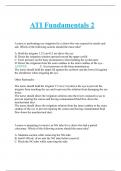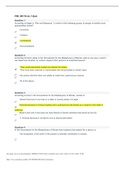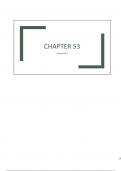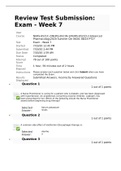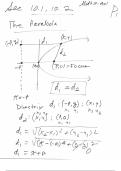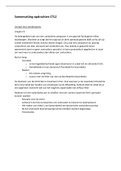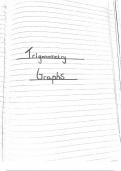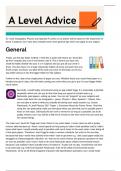CEP Lecture 4
06-12-2018
Do we need to know the content of Table 1 in the Evans et al. paper for the exam?
No, I wouldn't think so - there is a lot of information in that table. I would concentrate on what the lecturer covers in her lecture
tomorrow and study those aspects for the exam.
1
We will talk about water, sanitation and hygiene (WaSH) interventions in developing countries.
2
I would like to know from you what you fnd more disgusting to touch. Is it a toilet seat? Not your toilet seat but a general toilet
seat, for example here in the building. Or is it your personal phone? Who fnds it more disgusting to touch a toilet seat? Raise
your hands. People raise their hands. Who fnds it more disgusting to touch your personal phone? No one raises their hands.
3
Your phone is actually more dirty than any toilet seat here in the building. At least that’s according to some research which is
talked about in The Time Health. So, you’ll fnd on your phone more germs in general which can cause diseases than on a toilet
seat. In this article they then point out how you can clean your phone regularly, with what kind of solution, whatever, but in the
end what they say is still the best advice has more to do with you than your phone: wash your hands several times a day, the
experts say, and you’ll likely be just fne. So to have a clean phone, you should was your hands.
4
Handwashing is even more important due to other reasons. We will talk about this in this lecture. I will give a short introduction
about WaSH interventions. We will then repeat the 4 Ps of social marketing which were in one of the articles that you read for
today’s lecture. I will give a repetition of the RANAS approach to behavior change which was discussed in the second article for
today. Then we will look at more intern application namely a handwashing intervention which I conducted in Ethiopia. You also
read about this one but what we will focus on in the lecture is actually the psychological mechanisms of a handwashing
intervention.
5
After this lecture you’ll be able to describe the 4Ps of social marketing, apply them to water, sanitation and hygiene interventions
in developing countries, to apply psychological theories to explain and promote WaSH behavior and that you’re able to appraise
the role of psychological mechanisms in the process of marketing WaSH behavior.
6
How are those learning outcomes of today’s lecture related to the whole course? We will mainly focus on frst and last learning
objective for the course. It’s related to applying psychological theories in explaining and promoting changes in consumer
decision-making and behavior and to appraising the role of psychological mechanisms in the process of marketing a product (e.g.
advertising efectiveness).
7
Why are WaSH interventions relevant? Until today, the second leading cause of death in children under the age of 5 years
worldwide is still diarrheal disease. And the only disease which causes more death is pneumonia, which causes 18% (14+4) of
the deaths and diarrheal disease causes 14% of the deaths. The main causes of diarrheal disease are the consumption of unsafe
water, for example if people drink surface water from rivers or lakes or pumps, when they defecate in the open and when the
hand hygiene is not appropriate.
8
That also means that we can reduce diarrheal disease by so called WaSH interventions. If we improve the water quality for
example by putting up a borehole as you can see in the picture on the slide or if you provide safe sanitation for example lutrine,
or if you bring people to wash hands at key times then you can reduce diarrheal diasease tremendously. As you can see in this
graph, handwashing has the highest impact. You can achieve a reduction of 50%. Important with handwashing is that want you
want to do is reduce diarrheal disease in children below the age of 5 years because it’s that if you survive the frst years then you
have high chance to survive until old age and then you’ll die because of old age. We want to make sure that children below the
age of 5 years don’t die because of diarrheal disease. The important thing is not that those children wash their hands, but that
primary caregivers wash their hands, so the people who take care of the children. The key times for handwashing to prevent
diarrheal diasease is after contact with feces, or after the primary caregiver uses the toilet or cleans the baby’s bottom or things
like this, and before touching food, before cooking, before eating, before giving food to the children. Because water sanitation
hygiene interventions have such a high impact on diarrheal disease reduction, WaSH interventions are also really key task of aid
agencies in developing countries. So nearly all are applying in some form WaSH interventions.
9
The frst article of Evans et al. talked about the 4Ps and about social marketing related to water hygiene and sanitation.
Marketing in general is the promotion or selling of products or services. Social marketing, there what you want to do is to
promote socially benefcial behaviors such as consumption of safe water, use of lutrines or handwashing. Marketing in general
and social marketing usually applies a marketing mix. That means that the 4 Ps of social marketing are used: product, place,
price and promotion. These 4 Ps were discussed in the article by Evans that you read.
10
Work in pairs and repeat the 4 Ps of social marketing so that you know what it is and what examples are. So, defnitions and
descriptions of the 4Ps. We will use that later on in the lecture for another task.
11
What are the 4 Ps of social marketing? Any questions? In social marketing related to WaSH place can be everything that you said
now. It’s the place where you sell or can buy the product, it’s the place where you also conduct the behavior, so for example
where you wash your hands, it’s even the place where you held a promotion. So it’s all those diferent places. So it’s possible that
it’s broader than in the standard marketing, but what in WaSH social marketing place is referred to is really those 3 things. It’s
place of selling, place of promotion and place of behavior.
12
, Most WaSH interventions include all of those 4 Ps. So you have the numbers up here. So, nearly all have a product (97%) and also
nearly all have some sort of promotion (97%). Place (81%) and price (62%) is also considered in many of them. Also, quite a lot
(56%) of WaSH social marketing is based on psychological and communication theories. We will now look a bit more what it
means to apply psychological theories for WaSH interventions.
13
In the second article that you read for today’s lecture, the RANAS approach is explained. This approach was really developed for
interventions in water sanitation and hygiene. The main aim of RANAS approach is to increase efectiveness of behavior change
interventions based on theory, evidence and population-tailoring. What does that mean? Means that interventions should be
based on psychological theories on behavior change. Why should this increase the efectiveness of interventions? Theories of
behavior change summarize the key factors which drive behavior. If we pick an intervention that targets exactly those factors,
the chance that we can change behavior is much higher than when we just brainstorm “what could we do, what could we target
in an intervention” and then come up with something random. So, theories already contain all the knowledge which is out there
on what defnes behavior. The second idea of being evidence based basically means that interventions should be evaluated, so
did they work or didn’t they work. And in next interventions you use exactly the approaches which worked or at least try to
improve those that didn’t work. This comes from evidence-based medicine where it’s also the idea that you only continue to use
a medication if it actually helps and not if you don’t have any success with it. The last idea is to apply population-tailoring
interventions. Idea there is that even though there are theories which explain which factors afect behavior, in some populations
some factors are more relevant, in other populations other factors are more relevant. So to really have highest efectiveness in a
specifc population it’s best to target the factors which exactly in this population explain the behavior. That’s exactly what the
RANAS approach does.
14
This is the model, which is the core of the RANAS approach. It summarizes again this idea. We have behavior which we want to
change. For that we consider the key factors which have been found in behavior change theories. In het midden: key factors that
we found in theories (HBM, PMT, SCT, TPB, HAPA). The names of the theories are considered on the right. What the idea is, is that
you frst look in a specifc population which of these factors explain behavior and if you for example fnd that it’s mainly risk
factors which explain behavior in this specifc population, then you apply information behavior change techniques (zie links). If
you fnd that it’s ability factors then you use infrastructural, skill & ability behavior change techniques. That’s the main idea. You
fnd more details about this approach in the article.
HBM = Health Belief Model TPB = Theory of Planned Behavior
PMT = Protect Motivation Theory HAPA = Health Access Process Approach
SCT = Social Cognitive Theory
15
What we discuss now is an application of this approach which is a handwashing study that we conducted in Ethiopia.
16
What we did is a non-randomized control trial. Baseline data-collection. We worked together with Oxfam America who was mainly
funding the project and with Gayo Pastoral Developmental Initiative, that’s a local NGO. They implemented the interventions and
also helped with the baseline and follow-up. Where we worked was in the south of Ethiopia, in the Borena (or Borana) Zone. We
were working there in several communities. The main aim of this study/intervention was that we wanted to test whether theory-
based, evidence-based, population-tailored interventions were really better than standard interventions which are in general
used by aid agencies. A lot of aid agencies worldwide use or do WaSH interventions. The problem is that they are usually not
theory-based or evidence-based or population-tailored. They just come up with something and do it and then they kind of decide
“oh it seems to work, let’s do it again”. A lot of it is mainly based on knowledge provision so they just tell people how they for
example contract (diarrheal) disease and then they hope that they will change their behavior. But that might not be the most
efective strategy.
17
To start with the baseline. You have more detail on that in the article. We conducted a baseline data collection to determine the
behavior and behavioral factores which are in this specifc population explaining the handwashing behavior.
18
What we found is that descriptive and injunctive norms are especially relevant. So the higher the descriptive and injuctive norm
is, the more people report then to wash their hands at key times and also we found that remembering and commitment is
essential. Exam question: why remembering is essential for handwashing behavior. Remembering is especially relevant for
handwashing because you have to wash hands at key times. So for example, before preparing food, if I realize 10 minutes into
food preparation that I forgot to wash my hands it’s kind of too late, because I already contamined the food. So that’s why
remembering seems especially crucial for handwashing. What we found in addition is that there is basically no handwashing
infrastructure present in this population. And they apply a very cumbersome handwashing technique which you can see up here
in this picture. What they do is they have a jerry can, mostly it’s even bigger than this one, they poor water from the jerry can in
the mug and then from the mug over the hands, so that means that you always have only one hand free for handwashing. You
can try it at home, it’s really not nice to do it like this. The second problem is that households look a bit like this, water and soap
were not readily available. So you have somewhere the jerry can, somewhere the mug, the soap is again somewhere else. So if
you want to wash your hands, you frst have to look for all those things until you can start to wash your hands. So the situation is
really diferent than for us where we just go and turn on the tap, take soap and wash hands. We found that this might also be
something that we want to target.
19
For that, we came up with interventions. I frst talk shortly about the comparison interventions. What we use as a comparison is a
f diagram exercise that’s often applied by aid agencies. There basically the idea is that people come together and learn in a
group task what the roots of contamination are for diarrheal disease. We use this as a comparison intervention. This was used in
all groups and then the interventions that we used to target the descriptive norm, injunctive norm, remembering and
commitment, is public commitment in which people came together, committed publicly and that from now on that they want to
wash their hands at key times and when they did so they received a certifcate and also a head scarf as a sign of their
commitment. The second promotion or intervention was tippy tap promotion. A tippy tap is the yellow thing on the picture. It’s a
device to wash hands. So this branch on top of here would be on the foor and then you can tip on the branch and then the jerry
can fips and water comes out. It’s not that we constructed those tippy taps but we couraged them to build them and provided
some of the material for it. We applied the f diagram exercise in all 4 groups/kebeles. Education was given to all 4 groups. In
addition, in the second group we also applied pubic commitment. In the third group in addition the tippy tap promotion. In the
fourth group we had a combination of all 3 interventions (education, commitment and tippy tap).
06-12-2018
Do we need to know the content of Table 1 in the Evans et al. paper for the exam?
No, I wouldn't think so - there is a lot of information in that table. I would concentrate on what the lecturer covers in her lecture
tomorrow and study those aspects for the exam.
1
We will talk about water, sanitation and hygiene (WaSH) interventions in developing countries.
2
I would like to know from you what you fnd more disgusting to touch. Is it a toilet seat? Not your toilet seat but a general toilet
seat, for example here in the building. Or is it your personal phone? Who fnds it more disgusting to touch a toilet seat? Raise
your hands. People raise their hands. Who fnds it more disgusting to touch your personal phone? No one raises their hands.
3
Your phone is actually more dirty than any toilet seat here in the building. At least that’s according to some research which is
talked about in The Time Health. So, you’ll fnd on your phone more germs in general which can cause diseases than on a toilet
seat. In this article they then point out how you can clean your phone regularly, with what kind of solution, whatever, but in the
end what they say is still the best advice has more to do with you than your phone: wash your hands several times a day, the
experts say, and you’ll likely be just fne. So to have a clean phone, you should was your hands.
4
Handwashing is even more important due to other reasons. We will talk about this in this lecture. I will give a short introduction
about WaSH interventions. We will then repeat the 4 Ps of social marketing which were in one of the articles that you read for
today’s lecture. I will give a repetition of the RANAS approach to behavior change which was discussed in the second article for
today. Then we will look at more intern application namely a handwashing intervention which I conducted in Ethiopia. You also
read about this one but what we will focus on in the lecture is actually the psychological mechanisms of a handwashing
intervention.
5
After this lecture you’ll be able to describe the 4Ps of social marketing, apply them to water, sanitation and hygiene interventions
in developing countries, to apply psychological theories to explain and promote WaSH behavior and that you’re able to appraise
the role of psychological mechanisms in the process of marketing WaSH behavior.
6
How are those learning outcomes of today’s lecture related to the whole course? We will mainly focus on frst and last learning
objective for the course. It’s related to applying psychological theories in explaining and promoting changes in consumer
decision-making and behavior and to appraising the role of psychological mechanisms in the process of marketing a product (e.g.
advertising efectiveness).
7
Why are WaSH interventions relevant? Until today, the second leading cause of death in children under the age of 5 years
worldwide is still diarrheal disease. And the only disease which causes more death is pneumonia, which causes 18% (14+4) of
the deaths and diarrheal disease causes 14% of the deaths. The main causes of diarrheal disease are the consumption of unsafe
water, for example if people drink surface water from rivers or lakes or pumps, when they defecate in the open and when the
hand hygiene is not appropriate.
8
That also means that we can reduce diarrheal disease by so called WaSH interventions. If we improve the water quality for
example by putting up a borehole as you can see in the picture on the slide or if you provide safe sanitation for example lutrine,
or if you bring people to wash hands at key times then you can reduce diarrheal diasease tremendously. As you can see in this
graph, handwashing has the highest impact. You can achieve a reduction of 50%. Important with handwashing is that want you
want to do is reduce diarrheal disease in children below the age of 5 years because it’s that if you survive the frst years then you
have high chance to survive until old age and then you’ll die because of old age. We want to make sure that children below the
age of 5 years don’t die because of diarrheal disease. The important thing is not that those children wash their hands, but that
primary caregivers wash their hands, so the people who take care of the children. The key times for handwashing to prevent
diarrheal diasease is after contact with feces, or after the primary caregiver uses the toilet or cleans the baby’s bottom or things
like this, and before touching food, before cooking, before eating, before giving food to the children. Because water sanitation
hygiene interventions have such a high impact on diarrheal disease reduction, WaSH interventions are also really key task of aid
agencies in developing countries. So nearly all are applying in some form WaSH interventions.
9
The frst article of Evans et al. talked about the 4Ps and about social marketing related to water hygiene and sanitation.
Marketing in general is the promotion or selling of products or services. Social marketing, there what you want to do is to
promote socially benefcial behaviors such as consumption of safe water, use of lutrines or handwashing. Marketing in general
and social marketing usually applies a marketing mix. That means that the 4 Ps of social marketing are used: product, place,
price and promotion. These 4 Ps were discussed in the article by Evans that you read.
10
Work in pairs and repeat the 4 Ps of social marketing so that you know what it is and what examples are. So, defnitions and
descriptions of the 4Ps. We will use that later on in the lecture for another task.
11
What are the 4 Ps of social marketing? Any questions? In social marketing related to WaSH place can be everything that you said
now. It’s the place where you sell or can buy the product, it’s the place where you also conduct the behavior, so for example
where you wash your hands, it’s even the place where you held a promotion. So it’s all those diferent places. So it’s possible that
it’s broader than in the standard marketing, but what in WaSH social marketing place is referred to is really those 3 things. It’s
place of selling, place of promotion and place of behavior.
12
, Most WaSH interventions include all of those 4 Ps. So you have the numbers up here. So, nearly all have a product (97%) and also
nearly all have some sort of promotion (97%). Place (81%) and price (62%) is also considered in many of them. Also, quite a lot
(56%) of WaSH social marketing is based on psychological and communication theories. We will now look a bit more what it
means to apply psychological theories for WaSH interventions.
13
In the second article that you read for today’s lecture, the RANAS approach is explained. This approach was really developed for
interventions in water sanitation and hygiene. The main aim of RANAS approach is to increase efectiveness of behavior change
interventions based on theory, evidence and population-tailoring. What does that mean? Means that interventions should be
based on psychological theories on behavior change. Why should this increase the efectiveness of interventions? Theories of
behavior change summarize the key factors which drive behavior. If we pick an intervention that targets exactly those factors,
the chance that we can change behavior is much higher than when we just brainstorm “what could we do, what could we target
in an intervention” and then come up with something random. So, theories already contain all the knowledge which is out there
on what defnes behavior. The second idea of being evidence based basically means that interventions should be evaluated, so
did they work or didn’t they work. And in next interventions you use exactly the approaches which worked or at least try to
improve those that didn’t work. This comes from evidence-based medicine where it’s also the idea that you only continue to use
a medication if it actually helps and not if you don’t have any success with it. The last idea is to apply population-tailoring
interventions. Idea there is that even though there are theories which explain which factors afect behavior, in some populations
some factors are more relevant, in other populations other factors are more relevant. So to really have highest efectiveness in a
specifc population it’s best to target the factors which exactly in this population explain the behavior. That’s exactly what the
RANAS approach does.
14
This is the model, which is the core of the RANAS approach. It summarizes again this idea. We have behavior which we want to
change. For that we consider the key factors which have been found in behavior change theories. In het midden: key factors that
we found in theories (HBM, PMT, SCT, TPB, HAPA). The names of the theories are considered on the right. What the idea is, is that
you frst look in a specifc population which of these factors explain behavior and if you for example fnd that it’s mainly risk
factors which explain behavior in this specifc population, then you apply information behavior change techniques (zie links). If
you fnd that it’s ability factors then you use infrastructural, skill & ability behavior change techniques. That’s the main idea. You
fnd more details about this approach in the article.
HBM = Health Belief Model TPB = Theory of Planned Behavior
PMT = Protect Motivation Theory HAPA = Health Access Process Approach
SCT = Social Cognitive Theory
15
What we discuss now is an application of this approach which is a handwashing study that we conducted in Ethiopia.
16
What we did is a non-randomized control trial. Baseline data-collection. We worked together with Oxfam America who was mainly
funding the project and with Gayo Pastoral Developmental Initiative, that’s a local NGO. They implemented the interventions and
also helped with the baseline and follow-up. Where we worked was in the south of Ethiopia, in the Borena (or Borana) Zone. We
were working there in several communities. The main aim of this study/intervention was that we wanted to test whether theory-
based, evidence-based, population-tailored interventions were really better than standard interventions which are in general
used by aid agencies. A lot of aid agencies worldwide use or do WaSH interventions. The problem is that they are usually not
theory-based or evidence-based or population-tailored. They just come up with something and do it and then they kind of decide
“oh it seems to work, let’s do it again”. A lot of it is mainly based on knowledge provision so they just tell people how they for
example contract (diarrheal) disease and then they hope that they will change their behavior. But that might not be the most
efective strategy.
17
To start with the baseline. You have more detail on that in the article. We conducted a baseline data collection to determine the
behavior and behavioral factores which are in this specifc population explaining the handwashing behavior.
18
What we found is that descriptive and injunctive norms are especially relevant. So the higher the descriptive and injuctive norm
is, the more people report then to wash their hands at key times and also we found that remembering and commitment is
essential. Exam question: why remembering is essential for handwashing behavior. Remembering is especially relevant for
handwashing because you have to wash hands at key times. So for example, before preparing food, if I realize 10 minutes into
food preparation that I forgot to wash my hands it’s kind of too late, because I already contamined the food. So that’s why
remembering seems especially crucial for handwashing. What we found in addition is that there is basically no handwashing
infrastructure present in this population. And they apply a very cumbersome handwashing technique which you can see up here
in this picture. What they do is they have a jerry can, mostly it’s even bigger than this one, they poor water from the jerry can in
the mug and then from the mug over the hands, so that means that you always have only one hand free for handwashing. You
can try it at home, it’s really not nice to do it like this. The second problem is that households look a bit like this, water and soap
were not readily available. So you have somewhere the jerry can, somewhere the mug, the soap is again somewhere else. So if
you want to wash your hands, you frst have to look for all those things until you can start to wash your hands. So the situation is
really diferent than for us where we just go and turn on the tap, take soap and wash hands. We found that this might also be
something that we want to target.
19
For that, we came up with interventions. I frst talk shortly about the comparison interventions. What we use as a comparison is a
f diagram exercise that’s often applied by aid agencies. There basically the idea is that people come together and learn in a
group task what the roots of contamination are for diarrheal disease. We use this as a comparison intervention. This was used in
all groups and then the interventions that we used to target the descriptive norm, injunctive norm, remembering and
commitment, is public commitment in which people came together, committed publicly and that from now on that they want to
wash their hands at key times and when they did so they received a certifcate and also a head scarf as a sign of their
commitment. The second promotion or intervention was tippy tap promotion. A tippy tap is the yellow thing on the picture. It’s a
device to wash hands. So this branch on top of here would be on the foor and then you can tip on the branch and then the jerry
can fips and water comes out. It’s not that we constructed those tippy taps but we couraged them to build them and provided
some of the material for it. We applied the f diagram exercise in all 4 groups/kebeles. Education was given to all 4 groups. In
addition, in the second group we also applied pubic commitment. In the third group in addition the tippy tap promotion. In the
fourth group we had a combination of all 3 interventions (education, commitment and tippy tap).


